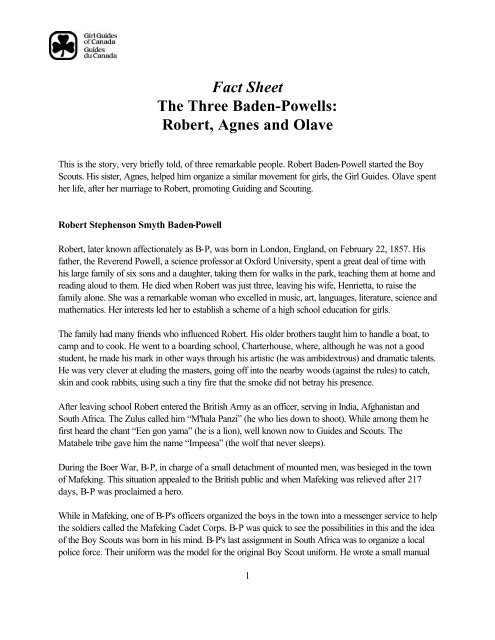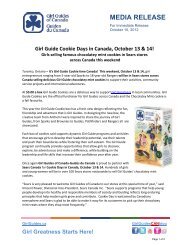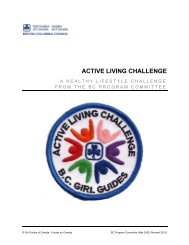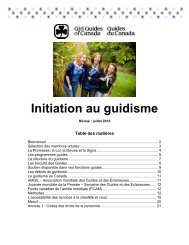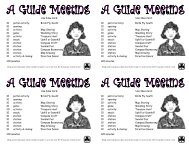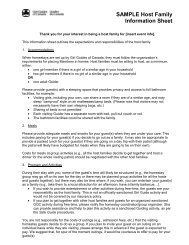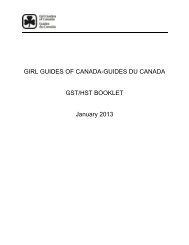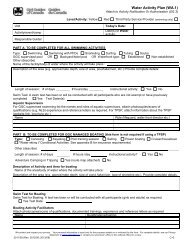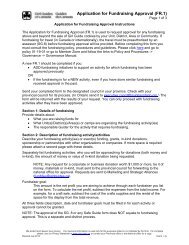Fact Sheet The Three Baden-Powells - Girl Guides of Canada.
Fact Sheet The Three Baden-Powells - Girl Guides of Canada.
Fact Sheet The Three Baden-Powells - Girl Guides of Canada.
You also want an ePaper? Increase the reach of your titles
YUMPU automatically turns print PDFs into web optimized ePapers that Google loves.
<strong>Fact</strong> <strong>Sheet</strong><strong>The</strong> <strong>Three</strong> <strong>Baden</strong>-<strong>Powells</strong>:Robert, Agnes and OlaveThis is the story, very briefly told, <strong>of</strong> three remarkable people. Robert <strong>Baden</strong>-Powell started the BoyScouts. His sister, Agnes, helped him organize a similar movement for girls, the <strong>Girl</strong> <strong>Guides</strong>. Olave spenther life, after her marriage to Robert, promoting Guiding and Scouting.Robert Stephenson Smyth <strong>Baden</strong>-PowellRobert, later known affectionately as B-P, was born in London, England, on February 22, 1857. Hisfather, the Reverend Powell, a science pr<strong>of</strong>essor at Oxford University, spent a great deal <strong>of</strong> time withhis large family <strong>of</strong> six sons and a daughter, taking them for walks in the park, teaching them at home andreading aloud to them. He died when Robert was just three, leaving his wife, Henrietta, to raise thefamily alone. She was a remarkable woman who excelled in music, art, languages, literature, science andmathematics. Her interests led her to establish a scheme <strong>of</strong> a high school education for girls.<strong>The</strong> family had many friends who influenced Robert. His older brothers taught him to handle a boat, tocamp and to cook. He went to a boarding school, Charterhouse, where, although he was not a goodstudent, he made his mark in other ways through his artistic (he was ambidextrous) and dramatic talents.He was very clever at eluding the masters, going <strong>of</strong>f into the nearby woods (against the rules) to catch,skin and cook rabbits, using such a tiny fire that the smoke did not betray his presence.After leaving school Robert entered the British Army as an <strong>of</strong>ficer, serving in India, Afghanistan andSouth Africa. <strong>The</strong> Zulus called him “M'hala Panzi” (he who lies down to shoot). While among them hefirst heard the chant “Een gon yama” (he is a lion), well known now to <strong>Guides</strong> and Scouts. <strong>The</strong>Matabele tribe gave him the name “Impeesa” (the wolf that never sleeps).During the Boer War, B-P, in charge <strong>of</strong> a small detachment <strong>of</strong> mounted men, was besieged in the town<strong>of</strong> Mafeking. This situation appealed to the British public and when Mafeking was relieved after 217days, B-P was proclaimed a hero.While in Mafeking, one <strong>of</strong> B-P's <strong>of</strong>ficers organized the boys in the town into a messenger service to helpthe soldiers called the Mafeking Cadet Corps. B-P was quick to see the possibilities in this and the idea<strong>of</strong> the Boy Scouts was born in his mind. B-P's last assignment in South Africa was to organize a localpolice force. <strong>The</strong>ir uniform was the model for the original Boy Scout uniform. He wrote a small manual1
on scouting, army style, for the police force, the first <strong>of</strong> many publications he produced.On his return to Britain, B-P became Inspector General <strong>of</strong> Cavalry and travelled widely in the line <strong>of</strong>duty. He found that his scouting manual was being used by the Boys' Brigade. After inspecting the boysand talking with their leader, he agreed to adapt his book for them. However, because <strong>of</strong> his concernabout the lack <strong>of</strong> “spirit” in British boys, particularly in those without the advantages <strong>of</strong> a goodeducation, he decided instead to form a new organization, the Boy Scouts. He felt what was neededwas a scheme <strong>of</strong> character training for boys. To promote his scheme he wrote a series <strong>of</strong> articles, <strong>of</strong> thepopular serial type, for a weekly boys' magazine. He later published these as a book Scouting forBoys. He demonstrated his ideas by holding a boys' camp on Brownsea Island <strong>of</strong>f the coast <strong>of</strong> Dorset.<strong>The</strong> boys needed no convincing. His serial stories were read eagerly all over Britain, and boys wereforming themselves into Scout patrols by the time the book was published.B-P, now 50 years old, resigned his commission in the Army and devoted all his time to Scouting,travelling widely to organize troops and to train leaders. In 1909, all Scouts who could get there wereinvited to a rally at the Crystal Palace in London. <strong>The</strong> parade numbered in the thousands <strong>of</strong> boys and, tothe surprise <strong>of</strong> everyone, some girls as well! <strong>The</strong>y too had been reading the scouting stories. <strong>The</strong>y hadregistered themselves as Scouts with Scout Headquarters and had obtained uniform items by using onlytheir initials and not their first names. <strong>The</strong>y demanded to be allowed to join the new organization. B-P, abachelor with the traditional views <strong>of</strong> women's roles that were common at the time, asked his sisterAgnes to help him organize a new movement, which he called <strong>Girl</strong> <strong>Guides</strong> after a famous IndianRegiment.In January 1912, B-P set <strong>of</strong>f for the West Indies starting an extended trip to promote Scouting in theUSA, Australia, New Zealand and South Africa. On board he met Mr. Harold Soames and hisdaughter Olave, who were going to spend a winter holiday in Jamaica. Olave and Robert found theyhad much in common, including the same birthdays, although born 32 years apart. By the time the shipreached Jamaica, they were un<strong>of</strong>ficially engaged and were married later that year, on October 30 th .In 1918 B-P wrote <strong>Girl</strong> Guiding, a program book for girls from eight to 18.Not long after World War I ended, the Scout organization bought a country house and adjoiningwoodlands near London. It was called Gilwell Park and was to be used as a training centre for Scoutleaders. Much later, when B-P was honoured with a peerage, he used Gilwell as his title.<strong>The</strong> 1920s were busy years for Scouting with international jamborees, the purchase <strong>of</strong> an internationalhome, Kanderstag, in Switzerland, culminating in 1929 when they celebrated their 21st anniversary atanother jamboree. At this event B-P was honoured by King George V and granted a peerage. Hebecame Lord <strong>Baden</strong>-Powell <strong>of</strong> Gilwell.Lord and Lady <strong>Baden</strong>-Powell did a great deal <strong>of</strong> travelling during these years, <strong>of</strong>ten taking their three2
children, Peter, Heather and Betty, with them. <strong>The</strong>y visited Scouts and <strong>Guides</strong> everywhere, including<strong>Canada</strong>, inspiring everyone who met them with their energy and enthusiasm.In 1937 B-P, now an old man and in failing health, bade farewell to his beloved Scouts at a jamboree inHolland. He and Olave celebrated their 25 th wedding anniversary later that year. <strong>The</strong>n in 1938 theymoved to Kenya so that they could spend B-P's last years together in the warm climate and sunshinethere. B-P was nominated for the Nobel Peace Prize in 1939, but no prize was given that year because<strong>of</strong> the outbreak <strong>of</strong> World War II. B-P, now very frail, died January 8, 1941. His grave in Nyeri, Kenya,bears a simple inscription: “Robert <strong>Baden</strong>-Powell, Chief Scout <strong>of</strong> the World,” with the Scout and Guideemblems and the familiar woodcraft symbol “I have gone home.”His life and work were later honoured with a memorial in Westminster Abbey, just inside the great westdoor, flanked by the Scout and Guide World Flags. He was honoured by many countries with medals,titles and decorations, but his greatest tribute will always be the millions <strong>of</strong> boys and girls who havefound happiness in the organizations he founded.Agnes <strong>Baden</strong>-PowellRobert's sister Agnes was born in 1858. Like her mother, she was a woman <strong>of</strong> many interests andaccomplishments. She would have been considered eccentric in Victorian times, and probably eventoday. She had some knowledge <strong>of</strong> 11 languages, astronomy and science. She was interested in naturalhistory and had artistic and writing talents. She was interested in crafts from needlework to metalwork.Her outside activities included cycling, swimming and skating. She even went up in a hot air balloon!She played the organ, piano and violin, had ability as a nurse, and was said to be a good cook andhousekeeper. She kept birds, bees and butterflies in her home.Being a woman <strong>of</strong> such wide interests, Agnes would almost certainly have been interested in herbrother's Scouting activities. In 1908 she started a Boy Scout Troop “in hopes <strong>of</strong> finding a man to takeit over.” She felt strongly that girls should have the benefit <strong>of</strong> something similar, “a corps <strong>of</strong> girls trainedto act in emergencies,” and started a “<strong>Girl</strong>s' Emergency Corps.”In 1909 when girls turned up at the Crystal Palace Rally clamouring to be allowed to join, there werealready 6,000 <strong>of</strong> them registered with Boy Scout Headquarters, practising their own form <strong>of</strong> Scouting.Robert asked Agnes to help him organize the <strong>Girl</strong> <strong>Guides</strong>. Together they published Pamphlet A andPamphlet B.Pamphlet A, called <strong>Baden</strong>-Powell <strong>Girl</strong> <strong>Guides</strong>, a Suggestion for Character Training for <strong>Girl</strong>s,contained information on how to start <strong>Girl</strong> <strong>Guides</strong> and a list <strong>of</strong> the efficiency badges girls could earn, 20<strong>of</strong> which would lead to the Silver Fish Award.3
<strong>The</strong>se, <strong>of</strong> course, were based on Scouting ideas, but adapted to suit girls. Agnes said “girls must bepartners and comrades, rather than dolls.” Readers were told that a handbook for girls was beingprepared but that in the meantime <strong>Girl</strong> Guide training could be carried out in the same way as inScouting for Boys (i.e., by games and competitions).Pamphlet B contained further information on program for girls. Patrols were to be named for flowers(which annoyed those who were already members <strong>of</strong> patrols named for animals) and the more than6,000 girls now registered as “temporary Scouts” would henceforth be called <strong>Girl</strong> <strong>Guides</strong>, “people whoknow the way and could show it to others.”In 1910 Agnes and some <strong>of</strong> her friends formed a committee to organize the <strong>Guides</strong>, with Agnes asPresident <strong>of</strong> the <strong>Girl</strong> <strong>Guides</strong> Association. B-P loaned money to rent <strong>of</strong>fice space in Scout Headquarters.Scouting for Boys was adapted for girls in a 475-page book called How <strong>Girl</strong>s Can Help to Build Upthe Empire, and published in 1912. In 1915 a charter was granted to the <strong>Girl</strong> <strong>Guides</strong> Association.Agnes was not apparently a very efficient organizer and for a time it looked as if the new organizationwould have to be taken over by the Boy Scouts. In 1920 she resigned as President in favour <strong>of</strong> PrincessMary, daughter <strong>of</strong> King George V, who was an active supporter <strong>of</strong> the <strong>Girl</strong> <strong>Guides</strong>. Agnes becameVice-President and continued in that position until her death in 1945. While Vice-President, she wasalways active, travelling in uniform, camping under canvas with the girls and writing articles, particularlyfor the <strong>Girl</strong> <strong>Guides</strong>' Gazette. She deserves credit for facing the prejudice <strong>of</strong> her time, against women inpublic life and against the very idea <strong>of</strong> an organization like <strong>Girl</strong> <strong>Guides</strong>.Olave St. Clair Soames (Olave, Lady <strong>Baden</strong>-Powell)<strong>The</strong> youngest child <strong>of</strong> Harold and Katharine Soames, Olave was born February 22, 1889, nearChesterfield, Derbyshire, England. Tradition has it that she was named for Olaf, King <strong>of</strong> Norway. Shespent a happy childhood in the country, devoted to her horses, dogs and birds. She was never sent toschool, but had a governess at home. She did not like book learning and her formal education endedwhen she was 12. She enjoyed outdoor activities: rowing, riding, cycling, tennis and swimming. She alsoenjoyed playing the violin.When Olave was old enough, she began to accompany her father on his winter holidays. It was on theway to Jamaica with him that she met the “Scout man,” General <strong>Baden</strong>-Powell. Although there was agreat difference in their ages - 32 years, they fell in love. B-P continued with his tour for Scouting andOlave returned to England with her father when the holiday was over. B-P wrote to his mother on her88th birthday: “I have been wondering what to give you as a birthday present but I think I've got onenow that will please you ... and that is a daughter-in-law for you.” Olave and her “Robin” had a quiet4
wedding in Dorset, October 30, 1912. In December there was a large wedding reception for them inLondon, after which they left on their honeymoon, camping in the desert <strong>of</strong> North Africa.<strong>The</strong>y found a home in Sussex and here their three children were born: Peter in 1913, Heather in 1915and Betty in 1917. Olave was, <strong>of</strong> course, interested in her husband's Scouting activities and soonbecame involved in <strong>Girl</strong> <strong>Guides</strong>. In 1916 she was appointed County Commissioner for Sussex and twoyears later became Chief Guide for Britain. In 1920 Olave helped form an International Council whichgrew and developed as Guiding grew, and eventually became the World Association <strong>of</strong> <strong>Girl</strong> <strong>Guides</strong> and<strong>Girl</strong> Scouts.<strong>The</strong> <strong>Baden</strong>-<strong>Powells</strong> had by now moved into a new home, Pax Hill, in Hampshire. It was a happy placewith Scouts and <strong>Guides</strong> visiting from all over the world. It was a busy place too with Robert directingthe Scouts and Olave deeply involved in her Guiding. However, busy as they were, they always foundtime to be with their children, and when the children went <strong>of</strong>f to boarding schools, they arranged theiractivities so as to be home for school holidays. Lady <strong>Baden</strong>-Powell usually accompanied the ChiefScout on his trips and <strong>of</strong>ten the three children went too as part <strong>of</strong> their education and to maintain familylife. Olave visited both Scouts and <strong>Guides</strong>, endearing herself to all with her infectious enthusiasm.By 1938 Olave had another home to make, this time in Kenya. It was called “Paxtu,” which in Swahilimeans “complete.” This was to be Robert's last home and while he enjoyed the sunshine, he wrote andpainted and enjoyed the view <strong>of</strong> “his” mountain, Mount Kenya. After B-P's death in 1941, Olave wasleft alone, cut <strong>of</strong>f by war from both England and her home there; Pax Hill had been taken over by theWar Department. She was granted a “Grace and Favour” apartment in Hampton Court Palace -apartments reserved for the reigning King or Queen to give to widows whose husbands had givenexceptional service to the country. At first because <strong>of</strong> the war she could not travel but found muchpleasure and satisfaction in her garden, she was especially proud <strong>of</strong> her rhubarb. She was nearly always“at home” to visiting Scouts and <strong>Guides</strong>, and her apartment was easily identified by the World Flag inthe window. Just a few days before the end <strong>of</strong> the war she managed to get to France where 40,000Scouts and <strong>Guides</strong> paraded past her down the Champs Elysees.By 1946 travel was again possible and Olave started her real work again, visiting Scouting and Guidingall over the world. During her lifetime she made many sea voyages, 648 flights, and visited manycountries, 15 visits to <strong>Canada</strong> alone. She was honoured by many countries and organizations for herwork for the youth <strong>of</strong> the world, work which she loved.In 1973 Olave left Hampton Court where she had lived for 28 years to move into a nursing home. Shedied there on June 25, 1977, aged 88. Her ashes were buried in B-P's grave in Kenya. Later in theyear, a memorial service was held in Westminster Abbey to celebrate her great life. <strong>The</strong> Abbey wasfilled not only with representatives <strong>of</strong> Guiding and Scouting but with government <strong>of</strong>ficials andrepresentatives <strong>of</strong> other organizations. Like the Chief Scout, Olave prepared a last message for “herfamily” before she died:5
Dear <strong>Guides</strong>, Scouts, Cubs and Brownies and all their leaders and friends:I shall have left this world when you receive this message, which I leave to express my thanks forall the kindnesses and the affection shown to me, and to say how greatly I rejoiced over the wayin which you have all carried out your share in the work <strong>of</strong> the movement that my belovedhusband invented for the advancement <strong>of</strong> boys and girls <strong>of</strong> all countries, years ago.I have firm belief in Almighty God and in the life in the world to come, when he and I will bereunited, and together we shall watch over you who have been enrolled as members <strong>of</strong> this worldfamily, and go on caring for your progress and your well-being.I trust that you will continue fully to use the system <strong>of</strong> work and play that our movementprovides, keeping up the fun and friendships made at your meetings and camps, abiding by thePromise and upholding the Laws that you undertook to live by when you joined up.In that way you will not only advance yourself in body, mind and spirit, but you will affect thosearound you, in doing what is honourable and right and wise, and in giving out kindness <strong>of</strong>thought and action, thus striving against all ills and helping to make the world a happier andbetter place in which to live.I trust you will be successful in all your tasks, and may God be with you in the coming years.6
References27 Years with B.P., Eileen K. Wade, 1957250 Million Scouts, Lazlo Nagy, 1985<strong>The</strong> Character <strong>Fact</strong>ory, Michael Rosenthal, 1984<strong>The</strong> First Fifty Years, Alix Liddell, 1970<strong>The</strong> Guider Handbook, Dorothy Crocker, 1988Help Yourself to Know <strong>Baden</strong>-Powell, Betty Clay, 1969Olave <strong>Baden</strong>-Powell, Eileen K. Wade, 1971Opening Doorways, Olave <strong>Baden</strong>-Powell, 1947Story <strong>of</strong> the <strong>Girl</strong> <strong>Guides</strong>, Rose Kerr, 1976Two Lives <strong>of</strong> a Hero, William Hillcourt, 1964Window on My Heart, told by Olave <strong>Baden</strong>-Powell to Mary Drewery, 1973<strong>The</strong> Wolf That Never Sleeps, Marguerite de Beaumont, 1944<strong>The</strong> World Chief Guide, Eileen K. Wade, 19637


